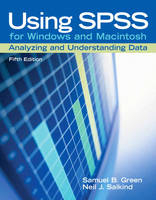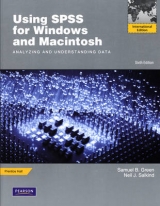
Using SPSS for Windows and Macintosh
Pearson (Verlag)
978-0-13-189025-1 (ISBN)
- Titel erscheint in neuer Auflage
- Artikel merken
Using SPSS guides students through the most basic of SPSS techniques using step-by-step descriptions, presents statistical techniques and instruction on how to conduct statistical analyses, and explains in detail how to avoid all the obstacles common in the study of statistics.
The development of easy-to-use statistical software like SPSS has changed the way statistics is being taught and learned. Students can make transformations of variables, create graphs of distributions of variables, and select among statistical analyses all at the click of a button. However, even with these advancements, students sometimes still find statistics to be an arduous task. They continue to be faced with many potential obstacles and they might feel overwhelmed and stressed rather than challenged and excited about the potential for mastering these important skills. Here, in Using SPSS for Windows and Macintosh 5e, Samuel Green and Neil Salkind have written a text to specifically address these issues. Using SPSS guides students through the most basic of SPSS techniques using step-by-step descriptions, presents statistical techniques and instruction on how to conduct statistical analyses, and explains in detail how to avoid all the obstacles common in the study of statistics.
Preface
Part I Introducing SPSS
Unit 1 Getting Started with SPSS
Lesson 1 Starting SPSS
Lesson 2 The SPSS Main Menus and Toolbar
Lesson 3 Using SPSS Help
Lesson 4 A Brief SPSS Tour
Unit 2 Creating and Working with Data Files
Lesson 5 Defining Variables
Lesson 6 Entering and Editing Data
Lesson 7 Inserting and Deleting Cases and Variables
Lesson 8 Selecting, Copying, Cutting, and Pasting Data
Lesson 9 Printing and Exiting an SPSS Data File
Lesson 10 Exporting and Importing SPSS Data
Lesson 11 Validating SPSS Data
Unit 3 Working with Data
Lesson 12 Finding Values, Variables, and Cases
Lesson 13 Recoding Data and Computing Values
Lesson 14 Sorting, Transposing, and Ranking Data
Lesson 15 Splitting and Merging Files
Unit 4A Working with SPSS Charts and Output for Windows
Lesson 16A Creating an SPSS Chart
Lesson 17A Enhancing SPSS Charts
Lesson 18A Using the Viewer and Pivot Tables
Unit 4B Working with SPSS Charts and Output for Macintosh
Lesson 16B Creating an SPSS Chart
Lesson 17B Enhancing SPSS Charts
Lesson 18B Using the Viewer and Pivot Tables
Part II Working with SPSS Procedures
Unit 5 Creating Variables and Computing Descriptive Statistics
Lesson 19 Creating Variables
Lesson 20 Univariate Descriptive Statistics for Qualitative Variables
Lesson 21 Univariate Descriptive Statistics for Quantitative Variables
Unit 6 t Test Procedures
Lesson 22 One-Sample t Test
Lesson 23 Paired-Samples t Test
Lesson 24 Independent-Samples t Test
Unit 7 Univariate and Multivariate
Analysis-of-Variance Techniques
Lesson 25 One-Way Analysis of Variance
Lesson 26 Two-Way Analysis of Variance
Lesson 27 One-Way Analysis of Covariance
Lesson 28 One-Way Multivariate Analysis of Variance
Lesson 29 One-Way Repeated-Measures Analysis of Variance
Lesson 30 Two-Way Repeated-Measures Analysis of Variance
Unit 8 Correlation, Regression, and Discriminant Analysis Procedures
Lesson 31 Pearson Product-Moment Correlation Coefficient
Lesson 32 Partial Correlations
Lesson 33 Bivariate Linear Regression
Lesson 34 Multiple Linear Regression
Lesson 35 Discriminant Analysis
Unit 9 Scaling Procedures
Lesson 36 Factor Analysis
Lesson 37 Internal Consistency Estimates of Reliability
Lesson 38 Item Analysis Using the Reliability Procedure
Unit 10 Nonparametric Procedures
Lesson 39 Binomial Test
Lesson 40 One-Sample Chi-Square Test
Lesson 41 Two-Way Contingency Table Analysis Using Crosstabs
Lesson 42 Two Independent-Samples Test: The Mann-Whitney U Test
Lesson 43 K Independent-Samples Tests: The Kruskal-Wallis and the Median Tests
Lesson 44 Two Related-Samples Tests: The McNemar, the Sign, and the Wilcoxon Tests
Lesson 45 K Related-Samples Tests: The Friedman and the Cochran Tests
Appendix A Data for Crab Scale and Teacher Scale
Appendix B Methods for Controlling Type I Error across Multiple Hypothesis Tests
Appendix C Selected Answers to Lesson Exercises
References
Index
| Erscheint lt. Verlag | 12.9.2007 |
|---|---|
| Sprache | englisch |
| Maße | 214 x 277 mm |
| Gewicht | 1004 g |
| Themenwelt | Mathematik / Informatik ► Mathematik ► Computerprogramme / Computeralgebra |
| ISBN-10 | 0-13-189025-5 / 0131890255 |
| ISBN-13 | 978-0-13-189025-1 / 9780131890251 |
| Zustand | Neuware |
| Haben Sie eine Frage zum Produkt? |
aus dem Bereich



